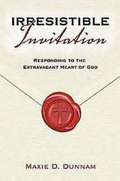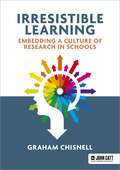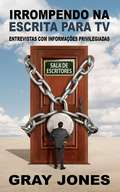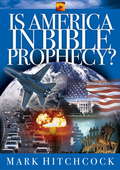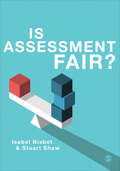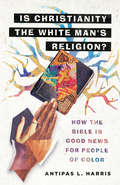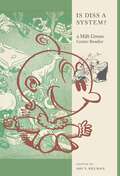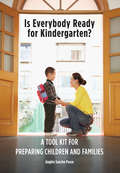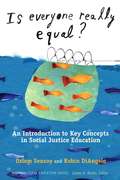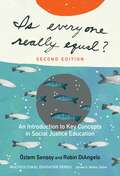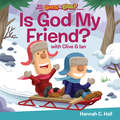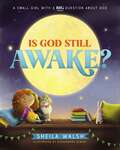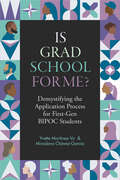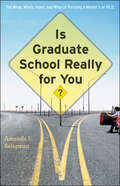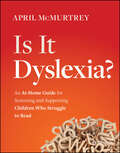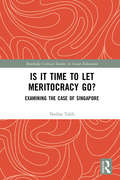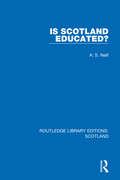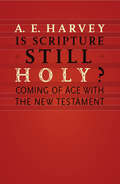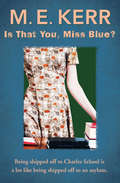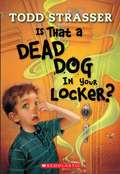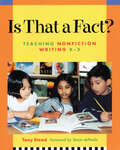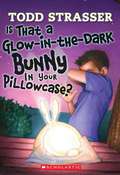- Table View
- List View
Irresistible Invitation 40 Day Reading Book: Responding to the Extravagant Heart of God
by Maxie DunnamMaxie Dunnam reminds us that accepting the invitation begins with a few quiet moments each day spent on deepening our relationship with God. Accept the invitation today!
Irresistible Learning: Embedding a culture of research in schools
by Graham ChisnellThis book will strengthen your research practice and help build a culture of research across your school. Whether you are a class teacher or school leader, you will be guided to use the power of research to strengthen practice in yourself and others. The author offers a practical guide on how to engage in meaningful research that will have a deep and lasting impact on you and your organisation. You will be taken on a journey through a Research Cycle that will build your confidence and purpose as a researcher; deepening professional relationships and improving outcomes for all. You will then be introduced to a range of systems that construct a culture of research in your school, building a climate where the voice of every member of staff is deeply valued and has the potential to influence the strategic development of the organisation. If you are interested in research in schools, this book is for you.
Irresistible Learning: Embedding a culture of research in schools
by Graham ChisnellThis book will strengthen your research practice and help build a culture of research across your school. Whether you are a class teacher or school leader, you will be guided to use the power of research to strengthen practice in yourself and others. The author offers a practical guide on how to engage in meaningful research that will have a deep and lasting impact on you and your organisation. You will be taken on a journey through a Research Cycle that will build your confidence and purpose as a researcher; deepening professional relationships and improving outcomes for all. You will then be introduced to a range of systems that construct a culture of research in your school, building a climate where the voice of every member of staff is deeply valued and has the potential to influence the strategic development of the organisation. If you are interested in research in schools, this book is for you.
Irrompendo na escrita para TV: entrevistas com informações privilegiadas
by Ana Claudia Antunes Gray Jones"Irrompendo na escrita para TV: entrevistas com informações privilegiadas" rompe mitos sobre como irromper nas salas dos roteiristas de Hollywood, e os substitu com informações privilegiadas e um plano de batalha sólido. Saiba como reconhecer o território, dicas e estratégias daqueles que vieram antes, oportunidades para aproveitar e armadilhas a evitar. Você vai encontrar um mapa de todas as ferramentas que você precisa para começar, e os caminhos tentados e testados para o seu objetivo. Além desses recursos, o livro apresenta transcrições completas de cinco entrevistas no podcast de roteiristas de TV: * Carole Kirschner (Plano de Jogo de Hollywood, Programa de Treinamento de showrunner) * Rick Muirragui (Suits, The Good Guys) * Matt MacLennan (The Listener, Call Me Fitz, Ecstasy de Irvine Welsh) * Aaron Ginsburg (The Finder, The Good Guys, The 100) * Bob DeRosa (Par Perfeito, Crimes do Colarinho Branco, Ligados Pelo Crime) Há muitos insights aplicáveis ao recurso para escrita de filmes também. Se você quiser irromper nesta indústria emocionante, comece aqui!
Is America in Bible Prophecy?
by Mark HitchcockProphecy expert Mark Hitchcock deals with often-raised questions about America's future in this thoroughly researched, reader-friendly resource. Examining three prophetic passages that are commonly thought to describe America, Hitchcock concludes that the Bible is actually silent about the role of the United States in the End Times. He then discusses the implications of America's absence in prophetic writings. Along with Hitchcock's compelling forecast for the future, he offers specific actions Americans can take to keep their nation strong and blessed by God, as well as an appendix of additional questions and answers. From the Trade Paperback edition.
Is Assessment Fair?
by Stuart D Shaw Isabel NisbetFairness in educational assessment has become a major talking point and allegations that assessments are unfair are commonplace on social media and in the press. But what does fairness mean in practice and how can we evaluate it? This book offers a timely and necessary investigation, exploring the concept through the lenses of: measurement theory, social justice, the law and philosophy in order to put forward a template for fairness in educational assessment. Drawing on international examples from the UK, US, Australia and South East Asia, this book offers a commentary on fairness that is highly relevant to the changing context of assessment today. This book will be of interest to anyone with a professional or academic interest in educational assessment, to education policymakers and to all who are working to make assessment fair.
Is Assessment Fair?
by Stuart D Shaw Isabel NisbetFairness in educational assessment has become a major talking point and allegations that assessments are unfair are commonplace on social media and in the press. But what does fairness mean in practice and how can we evaluate it? This book offers a timely and necessary investigation, exploring the concept through the lenses of: measurement theory, social justice, the law and philosophy in order to put forward a template for fairness in educational assessment. Drawing on international examples from the UK, US, Australia and South East Asia, this book offers a commentary on fairness that is highly relevant to the changing context of assessment today. This book will be of interest to anyone with a professional or academic interest in educational assessment, to education policymakers and to all who are working to make assessment fair.
Is Christianity the White Man's Religion?: How the Bible Is Good News for People of Color
by Antipas L. HarrisAmong many young people of color, there is a growing wariness about organized religion and Christianity in particular.Is Christianity the White Man's Religion?
Is Diss a System?: A Milt Gross Comic Reader (Goldstein-Goren Series in American Jewish History #16)
by Ari Y. KelmanMilt Gross (1895-1953), a Bronx-born cartoonist and animator, first found fame in the late 1920s, writing comic strips and newspaper columns in the unmistakable accent of Jewish immigrants. By the end of the 1920s, Gross had become one of the most famous humorists in the United States, his work drawing praise from writers like H. L. Mencken and Constance Roarke, even while some of his Jewish colleagues found Gross’ extreme renderings of Jewish accents to be more crass than comical.Working during the decline of vaudeville and the rise of the newspaper cartoon strip, Gross captured American humor in transition. Gross adapted the sounds of ethnic humor from the stage to the page and developed both a sound and a sensibility that grew out of an intimate knowledge of immigrant life. His parodies of beloved poetry sounded like reading primers set loose on the Lower East Side, while his accounts of Jewish tenement residents echoed with the mistakes and malapropisms born of the immigrant experience.Introduced by an historical essay, Is Diss a System? presents some of the most outstanding and hilarious examples of Jewish dialect humor drawn from the five books Gross published between 1926 and 1928—Nize Baby, De Night in de Front from Chreesmas, Hiawatta, Dunt Esk, and Famous Fimmales—providing a fresh opportunity to look, read, and laugh at this nearly forgotten forefather of American Jewish humor.
Is Everybody Ready for Kindergarten?: A Toolkit for Preparing Children and Familie
by Angèle Sancho PasseMaking the transition into kindergarten is a significant and exciting milestone in young children's lives. With proper coordination and planning, it can be a smooth process, benefiting children, families, and schools.<P><P> Is Everybody Ready for Kindergarten? provides early childhood professionals with information and practical advice to help children and their families prepare for the transition and then successfully begin kindergarten. Helpful activities and reproducible checklists and handouts are included.
Is Everyone Really Equal? An Introduction to Key Concepts in Social Justice Education
by Özlem Sensoy Robin DiangeloThis practical handbook will introduce readers to social justice education, providing tools for developing "critical social justice literacy" and for taking action towards a more just society. Accessible to students from high school through graduate school, this book offers a collection of detailed and engaging explanations of key concepts in social justice education, including critical thinking, privilege, and White supremacy. Based on extensive experience in a range of settings in the United States and Canada, the authors address the most common stumbling blocks to understanding social justice. They provide recognizable examples, scenarios, and vignettes illustrating these concepts. This unique resource has many user-friendly features, including "definition boxes" for key terms, "stop boxes" to remind readers of previously explained ideas, "perspective check boxes" to draw attention to alternative standpoints, a glossary, and a chapter responding to the most common rebuttals encountered when leading discussions on concepts in critical social justice. There are discussion questions and extension activities at the end of each chapter, and an appendix designed to lend pedagogical support to those newer to teaching social justice education.
Is Everyone Really Equal?: An Introduction to Key Concepts in Social Justice Education
by Özlem Sensoy Robin DiAngelo<P>This is the new edition of the award-winning guide to social justice education. Based on the authors' extensive experience in a range of settings in the United States and Canada, the book addresses the most common stumbling blocks to understanding social justice. <P>This comprehensive resource includes new features such as: a chapter on intersectionality and classism, discussion of contemporary activisms (Black Lives Matter, Occupy, and Idle No More), material on White Settler societies and colonialism, pedagogical supports related to "common social patterns" and "vocabulary to practice using," and extensive updates throughout. <P>Accessible to students from high school through graduate school, Is Everyone Really Equal? is a detailed and engaging textbook and professional development resourcer presenting the key concepts in social justice education. The text includes many user-friendly features, examples, and vignettes to not just define but illustrate key concepts.
Is God My Friend?
by Hannah C. HallFeaturing beloved characters Clive & Ian from the bestselling video series What's in the Bible?, IS GOD MY FRIEND? weaves the biblical truth that God is a friend into a fun story with delightful illustrations, teaching little learners that they can be close with God. "God does kind things for us because He is our friend."Clive and Ian are playing in the snow! Ian thanks God for the fun (but cold!) gift. Clive helps his little brother Ian discover why God does such nice things for them (like giving them snow for snowball fights!), and they share neat ideas for how they can grow even closer to God, their special friend.
Is God Still Awake?: A Small Girl with a Big Question About God
by Sheila WalshIn this delightful full-color picture book that teaches children about prayer, bestselling author Sheila Walsh helps you show your kids how, when, and why to talk with God as they learn more of who God is and how much He loves them!Inspired by the ways God has used her book Praying Women, Sheila Walsh wanted to share her passion for prayer with kids--a passion that began when she was a little girl who wondered if God could hear her any time of the day or night.Is God Still Awake? introduces curious young readers to Poppy: a little girl who has big questions about God! Poppy wants to know how to talk with God and whether God listens to her. As she goes through her day with her cat by her side, Poppy discovers that God is always there--even when the world is asleep!With humorous, rhyming text, Is God Still Awake? assures children that God loves them and is always with them. Whether it's day or night, God is awake, He's listening, and He loves to hear His children speak!This whimsical jacketed picture book is a perfect gift for:children ages 4 to 8Christmas, baptisms, birthdayschildren beginning their faith journeygrandparents to share their faith across the milestraveling, snuggling, or bedtime reading
Is Grad School for Me?: Demystifying the Application Process for First-Gen BIPOC Students
by Yvette Martínez-VuThe first book to provide first-generation, low-income, and nontraditional students of color with insider knowledge on how to consider and navigate graduate school Is Grad School for Me? is a calling card and a corrective to the lack of clear guidance for historically excluded students navigating the onerous undertaking of graduate school—starting with asking if grad school is even a good fit. This essential resource offers step-by-step instructions on how to maneuver the admissions process before, during, and after applying. Unlike other guides, Is Grad School for Me? takes an approach that is both culturally relevant and community based. The book is packed with relatable scenarios, memorable tips, common myths and mistakes, sample essays, and templates to engage a variety of learners. With a strong focus on demystifying higher education and revealing the hidden curriculum, this guide aims to diversify a wide range of professions in academia, nonprofits, government, industry, entrepreneurship, and beyond.
Is Graduate School Really for You?: The Whos, Whats, Hows, and Whys of Pursuing a Master's or Ph.D.
by Amanda I. SeligmanLanding a job in today's academic job market is no easy feat. Is graduate school the answer? This informed and candid book provides anyone thinking about pursuing an advanced degree—and those who support them—with the inside scoop on what to expect in graduate school. Amanda I. Seligman helps potential students navigate graduate study—not just how to get in but how to succeed once you are there and what to expect when you leave. She weighs the pros and cons of attending graduate school against achieving a sustainable work-life balance and explains the application process, the culture of graduate school, and employment prospects for academics.This book guides readers through the ins and outs of graduate school, and no topic is off limits, including• qualifications and admission guidelines• financial aid and graduate stipends• meeting expectations and residency requirements• coursework, theses, and dissertations• degrees, jobs, and academic careers• tenure, research, and peer review• social life (will you still have one?)Written in a question-and-answer format, Is Graduate School Really for You? eliminates the guesswork. Whether you are considering applying to graduate school, already enrolled, or would simply like to know more about continuing your education, this is the book for you.
Is It Dyslexia?: An At-Home Guide for Screening and Supporting Children Who Struggle to Read
by April McMurtreyHands-on resources for screening readers of all ages for dyslexia In Is It Dyslexia?, certified dyslexia assessment specialist April McMurtrey delivers an accessible, hands-on framework for screening readers of various ages for dyslexia.. The book offers comprehensive, clear, and step-by-step processes you can apply immediately to confidently and accurately screen readersfor dyslexia. The author shares the tools and strategies used by professional screeners, as well as first, next, and final steps you can take as you move forward with your screening results. The book includes: Explanations of what dyslexia is, as well as an overview of common talents and strengths often found in readers with dyslexia A collection of recommended accommodations for students with dyslexia in the home and school and effective literacy instruction for students with dyslexia A comprehensive dyslexia questionnaire, eleven different screening tests, and step-by-step instructions for administering themIdeal for tutors, homeschool teachers, parents, instructional coaches, counselors, and speech-language therapists, Is It Dyslexia? comes complete with reproducibles and links to video tutorials required for screening students of various ages.
Is It Time to Let Meritocracy Go?: Examining the Case of Singapore (Routledge Critical Studies in Asian Education)
by Nadira TalibDespite meritocratic claims of equal opportunity, official statistics released by the Ministry of Education, Singapore, reveal that a large segment of the Malay population has sustained the lowest academic achievement from 1987 to 2011. This statistical representation raises the possibility of a politically induced, systemic inequality as a point of investigation. To investigate this seeming contradiction between the rhetoric and practice of equal educational opportunity, Nadira Talib analyses education policies by drawing on a synthesis of philosophical perspectives and critical discourse analysis as a way of making explicit how the historical constitution of the learner is linked to the legitimisation of inequitable education policies that favour corporatist practices. By making explicit how the underlying assumption of the policy ‘logic’ that increasing expenditure on ‘talents’ must necessarily involve the increasing welfare of everybody is both unsubstantiated and arbitrary, the book presents a moral political problem in demonstrating how education policies are unfounded and unsupported through the idea of meritocracy.
Is Science Multicultural? Postcolonialisms, Feminisms, and Epistemologies
by Sandra HardingThis book explores what the last three decades of European/American, feminist, and postcolonial science and technology studies can learn from each other. Sandra introduces and discusses an array of postcolonial science studies.
Is Scotland Educated? (Routledge Library Editions: Scotland #21)
by A. S. NeillOriginally published in 1936, and with more than a slightly tongue-in-cheek tone at times, the author of this book declares that Scotland is not educated but merely learned. This book does not deal with education in its narrowest sense: it ranges from the Kirk to Haggis, Tartans and Burns, Whisky and repressed sex in its discussion, proclaiming Calvinism as the root of most of Scotland’s evils. Honest and at times provocative, this volume does give direct access to the emotional roots of Neill’s feelings about Scottish education.
Is Scripture Still Holy?: Coming of Age with the New Testament
by A. E. HarveyIn this volume A. E. Harvey asks, Is the notion of "Holy Scripture" still credible? In particular, in the light of modern critical study and postmodern literary theory, does the New Testament still qualify as a "holy" book? Arguing that the New Testament must continually subject its credentials to examination for historical reliability, internal consistency, and general plausibility, Harvey tests the Bible's historical credibility and plausibility in seven concise chapters. In dialogue with historical criticism, he compares the New Testament to other ancient documents, examines its presentation of Jesus, and considers the New Testament's validity as a moral guide in the twenty-first century. Harvey's careful examination leads him to conclude that a good case can still be made for the New Testament's authority and "holiness," subject to continual reassessment in the light of further advances in understanding and criticism.
Is That You, Miss Blue?
by M. E. KerrA teenager whose parents have separated tries to adapt to life at a boarding school and make a fresh start in a strange new placeAfter her mother runs off with her much-younger boyfriend, fourteen-year-old Flanders is shipped off to a boarding school in Virginia. On the train, she meets Carolyn Cardmaker, a preacher&’s daughter who will become her best friend. She also meets Ernestine Blue.Miss Blue is Flanders&’s faculty advisor at the Charles School, where each residence hall is named after a Charles Dickens novel. But Miss Blue&’s strict disciplinarian persona may be concealing a tragic past. As Flanders adjusts to life at school—which includes a deaf roommate and a terrifying blind date—she discovers surprising things about Miss Blue . . . and herself.A coming-of-age novel that transcends the ordinary in its perceptive, empathetic depiction of Flanders and the people in her life, Is That You, Miss Blue? takes us into a world where not everyone can be taken at face value—and where strangers can become unexpected friends.This ebook features an illustrated personal history of M. E. Kerr including rare images from the author&’s collection.
Is That a Dead Dog in Your Locker?
by Todd StrasserThe Tardy Boys, Wade and Leyton, are always getting into trouble, especially when they're dealing with the school bully, Barton Slugg. When their friend Daisy brings her neighbor's old dog Wheezy to school, the boys have to help her hide him. Not only does the school have a no-furry-animals-allowed policy, but the class crybaby is horribly allergic to animal fur. Barton is trying everything to uncover Wheezy's hiding place and get the boys in hot water. It will take the ingenious work of the Tardy Boys to outsmart him, with some hilarious results.
Is That a Fact?: Teaching Nonfiction Writing, K-3 (Tony Stead Content Area Collection Ser.)
by Tony SteadThe book you are about to read is destined to be the first, middle, and maybe even the last word on nonfiction writing for young, young children. It is certainly a text that you will return to over and over again as you do with a beloved cookbook.—from the Foreword by Tomie dePaola Over eighty- five percent of the reading and writing we do as adults is nonfiction, yet most of the reading and writing in K–3 classrooms is fiction or personal narrative. In Is That a Fact? Teaching Nonfiction Writing K-3, Tony Stead shows you how to open the door to the rich world of nonfiction writing that goes beyond what I did narratives and animal reports. And he convincingly demonstrates the importance of introducing nonfiction writing in the primary grades. Nonfiction inspires enthusiasm in young children because they can choose topics that are of interest to them personally. Is That a Fact? explores a variety of authentic purposes for writing nonfiction, such as describing, explaining, instructing, persuading, retelling, and exploring relationships with others. You will learn how to introduce each purpose using a variety of forms, including letters, reports, poetry, captions, directions, and interviews. Part One provides a complete overview of teaching nonfiction writing in the primary grades and includes:practical ways for organizing nonfiction resources within the classroom;how to assist children in collecting information for research;ideas for helping children keep their sense of voice when writing nonfiction;a chapter on spelling, with examples of how to guide students at each stage of spelling development;strategies for assessment and evaluation that guide teaching and learning engagements. Part Two provides five different explorations that were implemented in actual K–3 classrooms. Each focuses on a specific purpose for writing nonfiction and features:examples of whole-class, small-group, and independent instructional engagements;a comprehensive assessment rubric that will help teachers tailor instruction to the needs of all learners;an extensive resource section that includes lists of books in the exploration, grouped by readability levels;answers to the most commonly asked questions about teaching nonfiction writing. The appendixes include a self-assessment questionnaire, reproducible pages for exploring specific writing forms, and letters to parents. Children need to be introduced to the different purposes of nonfiction writing. They need to know how to plan, compose, revise, and publish nonfiction beyond narrative. Is That a Fact? guides you in achieving these goals with your students.
Is That a Glow-in-the-Dark Bunny in Your Pillowcase?
by Todd StrasserThis Halloween, Leyton and Wade Tardy are determined to come up with totally awesome costumes. Whoever has the best costume will win "The School With No Name's King of Candy Contest". Unfortunately, Fibby Mandible, the school's bossiest, snobbiest girl,and Barton Slugg, king of the archenemies, have their eyes on the same prize. And when the fiercest, meanest, most sinister aliens in the entire universe appear in the neighborhood, only Wade and Leyton can save the Earth from being destroyed. But can they win the candy contest and save the planet at the same time?
